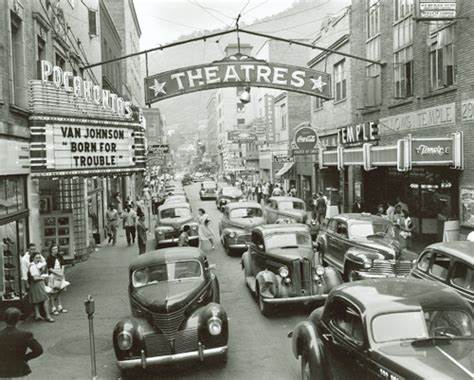(单词翻译:单击)
听力文本
Welcome to THE MAKING OF A NATION – American history in VOA Special English. I'm Steve Ember. World War Two finally ended in August of nineteen forty-five. Life in the United States began to return to normal. Soldiers began to come home and find jobs. Factories stopped producing war materials and began to produce goods for peacetime. At the same time, other changes began to take place in society. Many Americans were no longer satisfied with their old ways of life. They wanted something new and better. And many were now earning enough money to find that better life.
Millions of Americans moved out of cities and small towns. They bought newly built homes in suburban communities outside busy cities. Today, we look at the growth of suburbs and other changes in the American population in the years after World War Two. "And we'll have the living room right in here, and the kitchen right here so we can see the children playing in the yard." "Yeah, the children ... Children? Say, how many are you planning on? Not more than six, I hope. Maybe I better add a few more rooms back here." A married couple in a marketing film for the home building industry. The United States counts its population every ten years. The first census took place in seventeen ninety. At that time, the country had about four million people. One hundred years later, in eighteen ninety, the population was sixty-three million.
By nineteen fifty, there were more than one hundred fifty million people living in the United States. In the early years of America, the average mother had eight to ten children. Living conditions were hard. Many children died at an early age. Families needed a lot of help on the farm. So it was good to have many children. But over the years birth rates fell. Families began to have fewer and fewer children. By nineteen hundred, the average woman had only three or four children. In nineteen thirty-six, during the Great Depression, the average American mother gave birth to only two children. Things changed after World War Two. Suddenly, it seemed like every family started having babies. Parents were hopeful about the future.

There were lots of jobs. People felt the need for a family and security after the long, difficult years of the war. From nineteen fifty to nineteen sixty, the number of children between the ages of five and fourteen increased by more than ten million. The increase in births after the war produced what became known as the baby boom generation. An estimated seventy-eight million Americans were born between nineteen forty-six and nineteen sixty-four. Many of the new parents moved to homes in the new suburbs built outside the urban environment of cities. Usually a developer would buy land, maybe from a farmer, then clear it, level it and build houses on it. Young families would buy the houses with money that they borrowed from local banks.
Life was different in the suburbs – calmer, less crowded than life in the big city. There were all sorts of group activities. There were Boy Scouts and Girl Scouts. Parent-Teacher Associations at school. Outdoor cooking where families gathered in someone's backyard to eat hamburgers hot off the grill. Historian William Manchester described life in the suburbs in this way: The new suburbs were free, open, and honestly friendly to anyone except black people, whose time had not yet come. Manchester wrote, Families moving in found that their new friends were happy to help them get started. Children in the suburbs exchanged toys and clothing almost as though they were group property. When little Bobby outgrew his clothes, his mother gave them to little Billy across the street. People felt safe enough to leave their doors unlocked.
Parents did everything they could to make life good for their children. Between nineteen fifty and nineteen sixty, the number of boys playing on Little League baseball teams increased from less than one million to almost six million. The number of Girl Scouts increased by two million. Bicycle sales doubled. And it wasn't just two-wheeled transportation that experienced a boost. US new car production was stopped during World War Two, to allow those factories to produce airplanes, tanks, and other military vehicles for the war effort. With the prosperity of peacetime, many Americans visited auto dealerships for the first time in years, to replace that tired family car with something more up to date -- even luxurious. For many years, popular singer Dinah Shore invited optimistic post-war Americans to take to the highway and see their country in a Chevrolet.
重点解析
1.return to 回到;返回
She's planning to return to work once the children start school.
她正计划孩子一入学就恢复上班。
2.take place 发生;举行
Voting will take place on May 1.
投票将于5月1日进行。
3.a lot of 大量;很多
You used to see a lot of her, didn't you?
你过去常见她吧?
4.be happy to 乐于;很乐意
Our assistants will be happy to answer your queries.
我们的助理很乐意回答诸位的问题。
参考译文
欢迎收听VOA慢速英语之建国史话节目,我是史蒂夫·恩伯。第二次世界大战终于在1945年8月结束,美国人的生活开始恢复正常。士兵们开始回家找工作,工厂停止生产战争物资,开始为和平时期生产商品。与此同时,社会也开始发生其他变化。许多美国人不再满足于他们过去的生活方式,他们想要新的更好的东西,许多人现在挣了足够的钱来寻找更好的生活。
数百万美国人搬出了城市和小城镇,他们在繁华城市以外的郊区买了新房子。今天,我们来看看二战后,郊区的发展和美国人口的其他变化。“客厅在这儿,这是厨房,这样我们就可以看到孩子们在院子里玩耍了。”“是啊,孩子们……孩子们?喂,你打算要几个孩子?我希望不超过六个。也许我最好在后面多加几个房间。”这是家庭建筑行业营销电影中的一对夫妇。美国每十年统计一次人口,第一次人口普查发生在1790年。当时,美国有大约400万人口。100年后的1890年,人口是6300万。
到1950年,有超过一亿五千万人生活在美国。在美国早期,平均每个母亲有八到十个孩子。生活条件艰苦,许多孩子幼年时就去世了。干农活需要很多人,所以孩子多是件好事。但是这些年出生率下降了,人们要的孩子数开始越来越少。到1900年,平均每个妇女只有三、四个孩子。在1936年,在大萧条时期,美国母亲平均只生两个孩子。二战后情况发生了变化。突然,似乎每个家庭都开始生宝宝,父母对未来充满希望。
工作岗位很多。在经历了漫长而艰难的战争岁月之后,人们感到需要有家,需要安全感。从1950年到1960年,五岁到十四岁的儿童人数增加了一千万。战后出生人口的增加,产生了所谓的婴儿潮一代。估计七千八百万美国人出生于1946年至1964年间。许多新当父母的人搬到了市区以外的新郊区。通常情况下,开发商会从农民那里购买土地,进行清理、平整工作,然后在上面盖房子。年轻的家庭会用从当地银行借来的钱买房子。
郊区的生活不同于大城市的生活——那里平静,不那么拥挤。有各种各样的团体活动,有男童子军和女童子军,学校有家长教师协会,有户外烹饪,几家人聚在某人的后院吃烤架上热腾腾的汉堡包。历史学家威廉·曼彻斯特这样描述郊区的生活:新郊区是自由、开放的,对任何人都很友好,除了黑人,黑人的时代还没到来。曼彻斯特写道,搬来的家庭发现他们的新朋友乐于帮助他们开始新生活。郊区的孩子们交换玩具和衣服,就好像这些是集体财产一样。当小鲍比长高穿不下自己的衣服时,他的妈妈就把衣服给街对面的小比利。人们觉得不锁门也安全。
父母尽一切努力让孩子过上好日子。从1950年到1960年,在小联盟棒球队打球的男孩人数从不到100万增加到近600万。女童子军的人数增加了200万。自行车销量翻了一番。而且不仅仅是两轮运输经历了提振。美国的新车生产在二战期间停止,以便这些工厂能生产飞机、坦克和其他军用车辆。随着和平时期的繁荣,许多美国人多年来第一次造访汽车经销商,用更现代化的,甚至豪华的车辆来取代家里那辆破旧的汽车。有很多年,流行歌手黛娜·肖尔都邀请乐观的战后美国人乘坐雪佛兰上高速公路,看看自己的国家。
译文为可可英语翻译,未经授权请勿转载!


